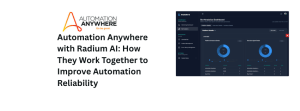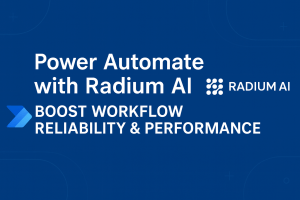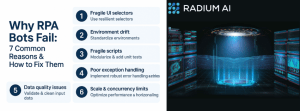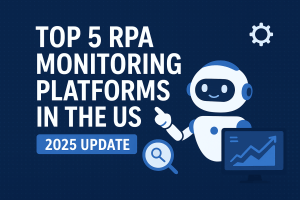As organizations scale their robotic process automation (RPA) programs, Virtual Desktop Infrastructure (VDI) sprawl becomes an expensive challenge. Digital workers sit idle, over-provisioned machines eat into budgets, and infrastructure teams lose visibility across fragmented environments. For Blue Prism users, the key to sustainable RPA lies in optimizing capacity and reducing waste without sacrificing automation velocity. (VDI sprawl in Blue Prism)
Here are ten powerful tips to help you take control of your environment:
- Right-Size Your Digital Workforce with Dynamic Scheduling
Instead of assigning a static bot-to-task ratio, use dynamic scheduling to intelligently allocate bots based on real-time load, SLA deadlines, and device availability. Platforms like Radium AI dynamically calculate which bots should run on which devices and at what time—eliminating the need for extra VDIs that are only occasionally used.
- Leverage Execution Windows Instead of Always-On Bots
Always-on bots consume infrastructure whether they’re active or idle. Define execution windows aligned with business processes (e.g., nightly reconciliation or weekly reports). This not only reduces VDI uptime but also allows you to schedule automations more strategically across available infrastructure.
- Consolidate Control Rooms and Optimize Queues
Multiple control rooms often lead to fragmented scheduling and inefficient queue management. Consolidate where possible and standardize queue naming conventions to simplify orchestration. Group similar processes in shared queues and apply priority-based scheduling to avoid over-provisioning.
- Analyze Bot Performance and Eliminate Low-Value Automations
Track metrics such as success rate, error frequency, and business impact for each automation. If a bot consistently fails or delivers little business value, retire or refactor it. Using dashboards like Radium AI’s “Top Errors” or “Top Incident Contributors” can help identify which automations are dragging down efficiency.
- Enable Auto-Healing and Intelligent Retry Logic
Avoid manual intervention by enabling self-healing bots that can detect and recover from known failures. This might include retrying after restarting a service, clearing session cache, or switching devices. Radium AI provides out-of-the-box low-code workflows that allow users to build these corrective actions rapidly.
- Set Thresholds and Alerts for Underutilized VDIs
Use observability tools to monitor and alert on low utilization. If a VDI is consistently under 30% active time, that’s a strong candidate for consolidation. Setting up automated alerts helps infrastructure and CoE teams take timely action before waste becomes embedded.
- Optimize Licensing Through Usage-Based Insights
Not all licenses need to be dedicated 24/7. With clear usage metrics, you can pool licenses across time zones or departments. This ensures high license utilization while reducing the total number of bots or sessions you need to maintain concurrently.
- Segment Processes by Priority and Schedule Accordingly
Establish automation tiers (critical, operational, opportunistic) and schedule accordingly. Critical bots should run on high-availability machines during peak hours, while opportunistic bots can run in batches during low-traffic periods, freeing up infrastructure and reducing conflicts.
- Centralize Failure Analysis and Resolution
Use ML-driven incident classification to speed up triage and recovery. Centralizing incident handling ensures consistent resolution and allows teams to rapidly identify recurring issues. Radium AI can ingest real-time failure data, apply root-cause analysis, recommend fixes, and trigger auto-resolutions—dramatically cutting MTTR (mean time to resolve).
- Visualize Capacity Trends and Forecast Needs
Historical data is gold. Use it to build capacity heatmaps and forecast peak periods, licensing needs, and infrastructure scaling timelines. With predictive insights, you can proactively allocate resources instead of reacting to failures or spikes after the fact.
How Radium AI Helps You Combat VDI Sprawl
Radium AI acts as a central nervous system for your RPA environment. By integrating directly with Blue Prism Control Rooms, it continuously collects and analyzes operational telemetry. Here’s how it helps optimize your capacity:
- Dynamic Scheduling Engine: Radium predicts when and where automations should run to minimize the number of concurrent VDIs needed, helping you meet SLAs without bloating infrastructure.
- Real-Time Monitoring and Alerts: It monitors execution delays, idle bots, and resource bottlenecks—alerting teams before these lead to system slowdowns or SLA breaches.
- Auto-Healing Workflows: With 200+ integrations and a low-code designer, Radium lets you automate recovery actions such as restarts, reruns, and ticket updates—without manual effort.
- Dashboards for Utilization and Business Impact: Visualize where capacity is wasted, which bots consume the most resources, and how automation impacts your bottom line—all in a single pane of glass.
- Governance Layer: Every failure is tracked, triaged, and resolved (or recommended for action), giving your CoE teams clear insights into areas of improvement and underperformance.
By embedding Radium into your Blue Prism ecosystem, you unlock a smarter, more responsive, and cost-effective automation environment.
Final Thoughts
As RPA matures, simply scaling automations isn’t enough—scaling efficiently is the new imperative. VDI sprawl can silently erode ROI and stifle your automation agility. The combination of thoughtful scheduling, continuous monitoring, and automation-aware analytics is key to staying lean and effective.
Tools like Radium AI not only reduce manual effort and infrastructure cost, but also elevate your automation program to a level of intelligence and proactivity that traditional dashboards and schedulers simply can’t match. With the right strategy and the right tooling, you can turn VDI sprawl into a competitive advantage—not a burden.








